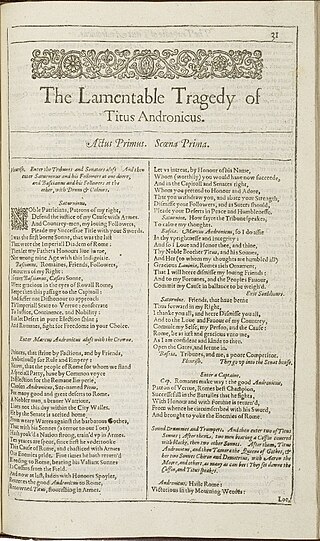
Titus Andronicus is a tragedy by William Shakespeare believed to have been written between 1588 and 1593. It is thought to be Shakespeare's first tragedy and is often seen as his attempt to emulate the violent and bloody revenge plays of his contemporaries, which were extremely popular with audiences throughout the 16th century.

The Royal Shakespeare Company (RSC) is a major British theatre company, based in Stratford-upon-Avon, Warwickshire, England. The company employs over 1,000 staff and produces around 20 productions a year. The RSC plays regularly in London, Stratford-upon-Avon, and on tour across the UK and internationally.

John Clare was an English poet. The son of a farm labourer, he became known for his celebrations of the English countryside and sorrows at its disruption. His work underwent major re-evaluation in the late 20th century; he is now often seen as a major 19th-century poet. His biographer Jonathan Bate called Clare "the greatest labouring-class poet that England has ever produced. No one has ever written more powerfully of nature, of a rural childhood, and of the alienated and unstable self."
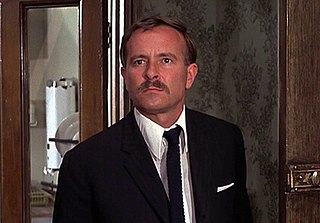
Alexander Duncan McCowen, was an English actor. He was known for his work in numerous film and stage productions.

Brian Alfred Christopher Bushell Sewell was an English art critic. He wrote for the Evening Standard and had an acerbic view of conceptual art and the Turner Prize. The Guardian described him as "Britain's most famous and controversial art critic", while the Standard called him the "nation’s best art critic".
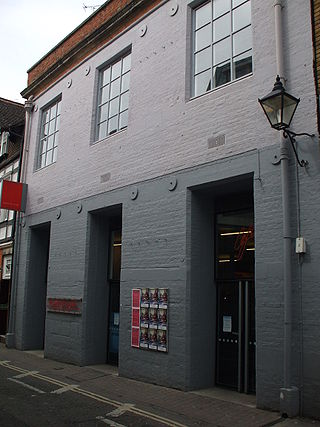
Modern Art Oxford is an art gallery established in 1965 in Oxford, England. From 1965 to 2002, it was called The Museum of Modern Art, Oxford.
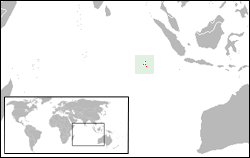
Captain William Keeling, of the East India Company, was a British sea captain. He commanded the Susanna on the second East India Company voyage in 1604. During this voyage his crew was reduced to fourteen men and one of the ships vanished. On the third voyage he commanded the Red Dragon and the Hector in 1607. During this voyage he met with an ambassador from the Siamese Ayutthaya Kingdom in 1608 at Bantam at the west end of Java. He discovered the Cocos (Keeling) Islands in 1609 as he was going home from Banda to England.

Sir Andrew Jonathan Bate, CBE, FBA, FRSL, is a British academic, biographer, critic, broadcaster, scholar, and occasional novelist, playwright and poet. He specializes in Shakespeare, Romanticism and Ecocriticism. He is Foundation Professor of Environmental Humanities in a joint appointment of the College of Liberal Arts, the School of Sustainability and the Global Futures Laboratory at Arizona State University, as well as a Senior Research Fellow at Worcester College in the University of Oxford, where he holds the title of Professor of English Literature. Bate was Provost of Worcester College, Oxford, from 2011 to 2019. From 2017 to 2019 he was Gresham Professor of Rhetoric in the City of London. He was knighted in 2015 for services to literary scholarship and higher education.
The Paul Mellon Centre for Studies in British Art is a scholarly centre in London devoted to supporting original research into the history of British Art. It was founded in 1970 and endowed by a gift from Paul Mellon. Since 1996, it has been situated at 16 Bedford Square in a Grade I listed building. This building houses an outstanding library of 26,000 publications focused on British art and architecture, and over 25 collected archives which include papers of eminent art historians such as Ellis K. Waterhouse, Oliver Millar, Brian Sewell and Brinsley Ford. It also holds the records of its own institutional archives, including a growing oral history collection. The centre compiled its own photographic archive from 1970 to 1996 and now also holds the Tate photographic archive. All of these research collections are available to consult in the centre's Public Study Room.
Shakespeare's Sonnet 53, presumably addressed to the same young man as the other sonnets in the first part of the sequence, raises some of the most common themes of the sonnet: the sublime beauty of the beloved, the weight of tradition, and the nature and extent of art's power. As in Sonnet 20, the beloved's beauty is compared to both a man's (Adonis) and a woman's (Helen).
Dora May Billington (1890–1968) was an English teacher of pottery, a writer and a studio potter. Her own work explored the possibilities of painting on pottery.
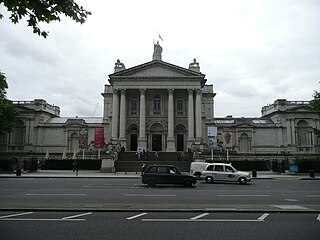
The 2008 Turner Prize was awarded on 1 December 2008 to Mark Leckey. The £25,000 Turner Prize is awarded by the Tate to one of four nominees and is based on their work in the previous year. The other three 2008 nominees were Runa Islam, Goshka Macuga and Cathy Wilkes; for the first time since 1998, there were three female nominees. The chairman of the jury was Stephen Deuchar, director of Tate Britain. The artwork shown by the nominees at the invitational exhibition was generally unpopular with critics.

The Cobbe portrait is an early Jacobean panel painting of a gentleman which has been argued to be a life portrait of William Shakespeare. It is displayed at Hatchlands Park in Surrey, a National Trust property, and the portrait is so-called because of its ownership by Charles Cobbe, Church of Ireland (Anglican) Archbishop of Dublin (1686–1765). There are numerous early copies of the painting, most of which were once identified as Shakespeare.
The Brooch of Lorn or Braìste Lathurna in Gaelic, is a medieval "turreted" disk brooch supposedly taken from Robert the Bruce at the Battle of Dalrigh in 1306. However it is today dated long after this period.
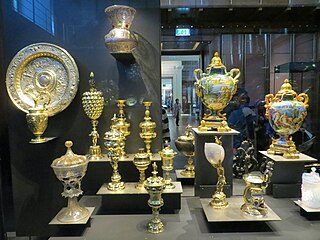
In 1898 Baron Ferdinand de Rothschild bequeathed to the British Museum as the Waddesdon Bequest the contents from his New Smoking Room at Waddesdon Manor. This consisted of a wide-ranging collection of almost 300 objets d'art et de vertu, which included exquisite examples of jewellery, plate, enamel, carvings, glass and maiolica. One of the earlier objects is the outstanding Holy Thorn Reliquary, probably created in the 1390s in Paris for John, Duke of Berry. The collection is in the tradition of a schatzkammer, or treasure house, such as those formed by the Renaissance princes of Europe; indeed, the majority of the objects are from late Renaissance Europe, although there are several important medieval pieces, and outliers from classical antiquity and medieval Syria.
Richard Dorment, is a British art historian and exhibition organiser. He worked as chief art critic for The Daily Telegraph from 1986 until 2015.

Blonde Bather is the name of two very similar paintings by French painter Pierre-Auguste Renoir, created in 1881 and 1882. The model was Aline Charigot, later to become Renoir's wife. Influenced by Renaissance painting that Renoir saw in Italy in 1881, both paintings show a marked change of style from Renoir's previous work. Some commentators consider these are works of great beauty, others that they are vulgar. There has been criticism of the conservation work performed on the 1881 painting.
Emma Pallant is a British theatre and television actress. She is known for classical work at Shakespeare's Globe, The Royal Shakespeare Company, and Regent's Park theatres, with notable roles including Jaques, Beatrice, and Imogen (Cymbeline). Pallant is also known for her appearances in various UK television dramas, including Casualty, Father Brown and Holby City.
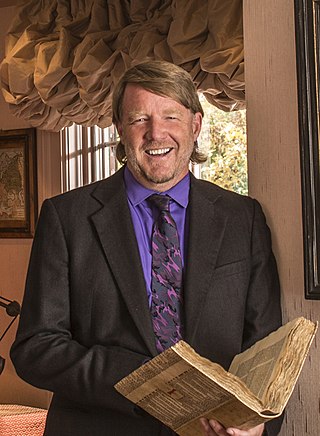
Eric Rasmussen is an American scholar, academic and author. He is Regents Teaching Professor and Foundation Professor of English at the University of Nevada.

Hajj: Journey to the Heart of Islam was an exhibition held at the British Museum in London from 26 January to 15 April 2012. It was the world's first major exhibition telling the story, visually and textually, of the hajj – the pilgrimage to Mecca which is one of the five pillars of Islam. Textiles, manuscripts, historical documents, photographs, and art works from many different countries and eras were displayed to illustrate the themes of travel to Mecca, hajj rituals, and the Kaaba. More than two hundred objects were included, drawn from forty public and private collections in a total of fourteen countries. The largest contributor was David Khalili's family trust, which lent many objects that would later be part of the Khalili Collection of Hajj and the Arts of Pilgrimage.














